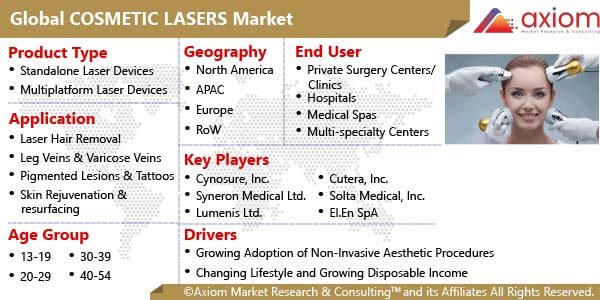Cosmetic lasers are widely used in cosmetic dermatology owing to its speed and efficiency. a laser is a concentrated light beam and can be very powerful. the light produced is composed of one single colour at a specific wavelength, unlike a light bulb or flashlight in which the light is made up of a rainbow of colours. the light from a laser is very focused and travels in an extremely narrow beam with a high power per unit area. Additionally, there are different laser options available in the market is as no one laser can treat all patients and all skin concerns an increasingly sophisticated understanding of the biophysics of laser tissue interactions has led to a more effective utilization of the present technology on the clinical side, and at the same time is helping the physicists to add highly selective cosmetic laser systems in the market. During the 1990s, the use of lasers offered aesthetic doctors and cosmetic dermatologists’ new possibilities. The beam revolution started with CO2 laser for facial resurfacing. Today, CO2 resurfacing is not used as much anymore, because of the long and difficult post-op. CO2 laser was replaced by the gentler Nd:YAG and Erbium lasers and more recently by non-invasive photonic devices for facial rejuvenation, including IPL, US and radiofrequency.
Cosmetic lasers Market Outlook
The global cosmetic lasers market has gained remarkable growth due to increasing adoption of non-invasive cosmetic procedures, surging aging population and technological advancements. Furthermore, increasing innovative product launches and growth of medical tourism across the globe are propelling the overall market growth. Development of low-cost cosmetic lasers and increase in number of aesthetic procedures driven by social media are some of the opportunities which are expected to fuel the growth of this market in coming years. However, the global cosmetic lasers market is hampered by stringent regulatory environment and social stigma associated with cosmetic treatments. However, proven advancement in technologies can help in creating better cosmetic products & services in future.
Cosmetic lasers market Segmental Overview
The global cosmetic lasers market is segmented into, laser type, application, end user and geography.
Cosmetic Lasers Market by Laser Type
Based on laser type the global cosmetic lasers market is segmented into, standalone laser devices and multiplatform laser devices. The standalone laser devices are further bifurcated into Carbon Dioxide (CO2) Lasers, Erbium YAG (Er: YAG) Laser, Diode Lasers, Pulsed Dye Lasers (PDL), Neodymium: Yttrium-Aluminium-Garnet (Nd: YAG) Laser, Alexandrite Lasers and Other Devices include Ruby, Argon, Krypton, and Erbium: glass Lasers. The CO2 lasers dominated the cosmetic lasers market in 2017.
Cosmetic Lasers Market by Application
Based on application, the global cosmetic lasers market is categorised into, laser hair removal, leg veins & varicose veins, pigmented lesions & tattoos, skin rejuvenation, vascular lesions, acne, & scars and other applications (gynaecological conditions, onychomycosis etc. Among various applications, the laser hair removal segment held the largest share of the cosmetic lasers market in 2017, due to growing aesthetic consciousness and altering beauty concepts. As, conventional hair removal techniques are time consuming and are not feasible in the current fast-moving lifestyle, laser hair removal gives a permanent solution to customers. According to the International Society of Aesthetic Plastic Surgery the worldwide laser hair removal procedures register was 1,146,523.
Cosmetic Lasers Market by End User
The major end user of the cosmetic lasers are private surgery centres/clinics, hospitals, medical spas and multi-specialty centres. Among these, the private clinics segment is anticipated to grow at the highest CAGR, chiefly due to the growing number of clinics and disposable income in emerging economies such as China and India, increasing preference for non-invasive procedures, and reduced cost for laser-based treatments.
Cosmetic Lasers Market by Geography
The global cosmetic lasers market is studies across key regions such as North America, Europe, Asia Pacific, and Rest of the world. North America is estimated to account for the largest share in 2017, followed by Europe and Asia-Pacific. Factors such as high awareness regarding aging and increasing prevalence of skin problems including acne, pigmentation and scarring are fuelling the growth of cosmetic lasers in North America. The presence of large number of medical sanitoriums & salons and beauty centres coupled with presence of skilled people is the significant driving factor of the U.S. cosmetic laser market
Cosmetic Lasers Market Key Players
Some of the major players operating in the cosmetic lasers market include Aerolase Corporation, Cutera, Cynosure, Inc. (A Hologic Company), Deka M.E.L. A S.r.l (El.En. Group), Lumenis (XIO Group, STRATA Skin Sciences, Lynton lasers, Sciton, Inc, SharpLight Technologies, Viora and Syneron Medical Ltd. Market players are involved in product launches and collaboration agreements to exploit maximum revenue potential in global cosmetic lasers market. For instance, in July 2018, Lumenis Ltd., the largest energy-based medical device company for surgical, aesthetic, and ophthalmic applications, announced its newest launch, NuEra tight, which is a non-invasive, intelligent temperature-controlled technology for both superficial and deep heating that treats a variety of conditions such as skin laxity and the appearance of cellulite.











